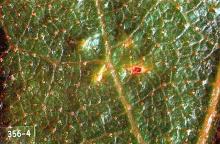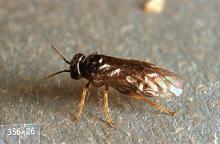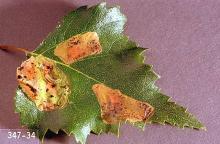Fenusa pumila
Pest description and damage The adults are a small (0.125 to 0.375 inch in length) black sawfly. Mature larvae are flattened and up to 0.5 inch long. The larvae feed between the leaf surfaces, leaving blotch-shaped or winding brown mines. Severe infestations over consecutive seasons may result in decline of trees. Vigorous gray, white, and paper birches are attacked most. In some years, infestations are heavy.
Biology and life history The adult sawfly lays eggs in new leaves. When fully developed, the larvae drop to the ground and pupate in the soil for two to three weeks before emerging as adults. There may be up to four generations per year, depending on the length of growing season.
Pest monitoring Check leaves once they are fully formed to assess the numbers starting in spring. Revisit trees to check on the population of subsequent generations.
Management-cultural control
Pinch leaves to kill larvae in minor infestations in small trees. Plant resistant species and cultivars that include Betula costata, B. davurica, B. maximowicziana, B. utilis var. jacquemontii, B. nigra, B. schmidtii, and the varieties 'Crimson Frost' and 'Purple Rain.'
Management-biological control
Severe infestations are soon brought under control by natural enemies. Monitor to determine if parasites or predators are active before initiating controls.
Management-chemical control
See Table 2 in:




